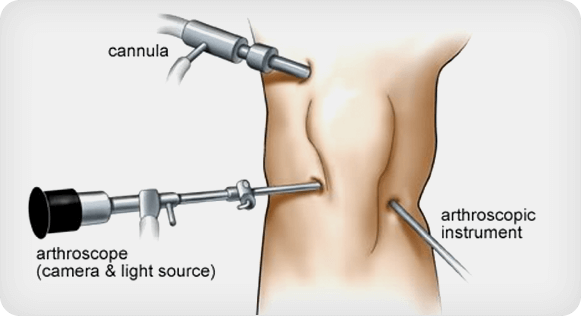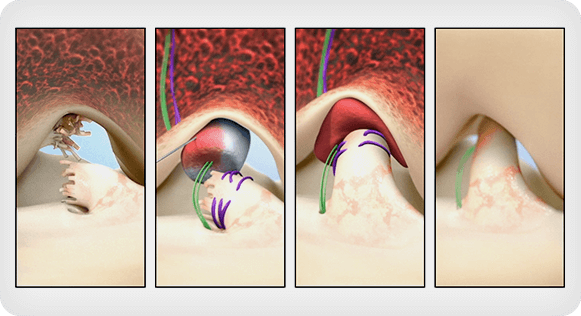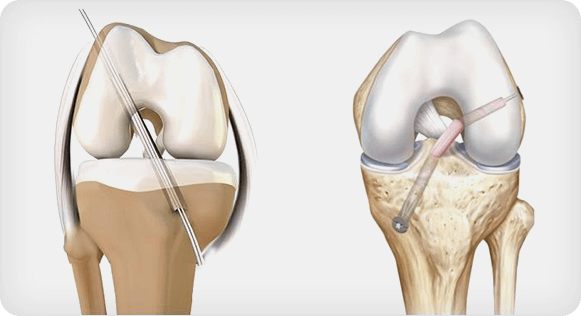- Overview
- Anterior Cruciate Ligament (ACL) Clinic
- Shoulder Labral Clinic
- Apollo Clinical Team
Treatment
ONLY A SMALL PROPORTION OF PATIENTS NEEDS SURGERY MAJORITY DOESN’T NEED SURGERY
Treatment for an ACL tear/injury will vary depending upon the patient’s individual needs, type of tear, chronicity of tear, presence of concomitant injuries & functional demands of the patients
Non-surgical Treatment
Most ACL Injuries could be managed non-operatively provided patient understands the pros & cons of this conservative treatment option & their determination in doing the exercise/rehabilitation programme.
Non-surgical treatment can be more effective for patients who are elderly or having comparatively a very low activity level.
- Bracing: A brace may be recommended to protect the knee from instability. For further protection of the knee, doctors may suggest for crutches for shifting the weight off the most damaged portion of the knee.
- Physical Therapy: As the swelling goes down, a carefully tailored rehabilitation program is started which is highly effective in many ways. Specific exercises restore the functioning of the knee and strengthen the leg muscles that support it.
Surgical Treatment
In some cases of Anterior Cruciate Ligament (ACL) injury, our Sport Medicine doctor recommends surgery to regain full functioning of the knee. This will depend on several factors, such as the severity of the injury, type of tear and the activity level.
Rebuilding or Reconstructing the ligament: Very few ACL tears can be directly repaired that too with some kind of augmentation device placed as a scaffold but most ACL tears cannot be (stitched) back together. To surgically restore the ACL and knee stability, the ligament must be reconstructed. The Sport Medicine specialist replaces the torn ligament with a tissue graft. This graft acts as a scaffolding for a new ligament & provide stability.
Grafts can be obtained from several sources. Hamstring tendons at the back of the thigh are a common source of grafts, they are also taken from the patellar tendon, which runs between the kneecap and the shinbone. In some cases, a quadriceps tendon is used, which runs from the kneecap into the thigh. A cadaver graft (also known as allograft) can also be used. There are advantages and disadvantages to all graft sources. You should discuss graft choices with your surgeon to help determine which is best for you.
Procedure: Surgery to rebuild an anterior cruciate ligament is performed with an arthroscope via small incisions. Arthroscopic surgery is a minimally invasive surgery. The benefits of minimally invasive technique are:
- less pain from surgery
- reduces duration of hospital stay
- faster recovery
KNEE ARTHROSCOPY:

ACL REPAIR:

ARTHROSCOPIC ACL RECONSTRUCTION:

Because the regrowth takes time, it may be nine months or more before an athlete can return to sports after surgery.
ACL Rehabilitation Programme
Rehabilitation programme plays a major role in putting the patient back to their daily activities, whether the patient underwent surgery or not. A physical therapy or physiotherapy program helps the patient to regain the knee strength and motion.
For patients who underwent surgery the primary focus of physical therapy is to return motion to the joint and its surrounding muscles. Followed by a strengthening program, specially designed to protect the new ligament. Thus, the strengthening program gradually increases the stress across the ligament. The last phase of rehabilitation aims at a functional return tailored for the athlete’s sport.
The main objective ACL Rehabilitation Programme:
- Regain good functional stability
- Restore muscle strength
- Reach the best possible functional level
- Reduce the risk for re-injury
ACL Injury Prevention
The risk of ACL injuries can be reduced with appropriate training and exercise. Our sports medicine specialist can provide a detailed assessment, instruction and feedback that can reduce risks of ACL injuries.
A glimpse of our ACL injury prevention program:
- Exercises to strengthen leg muscles, especially quadriceps & hamstring exercises, which will ensure an overall balance in leg muscle strength
- Exercises to strengthen the core, which includes hips, pelvis and lower abdomen
- Emphasize on training and exercise, for proper technique and knee position while jumping and landing from jumps
- Emphasize on training to improve techniques while performing pivoting and cutting movements




